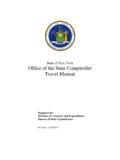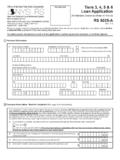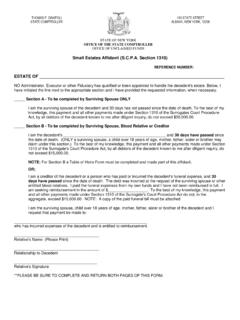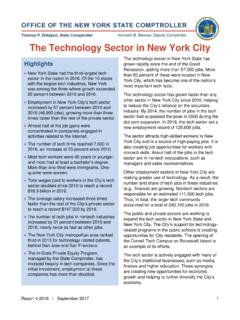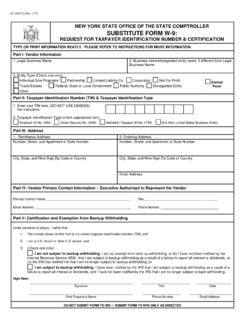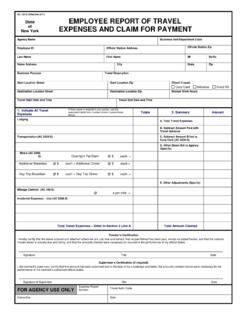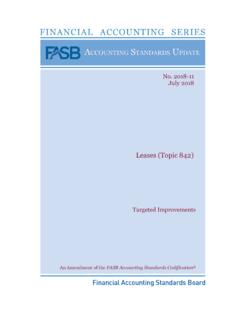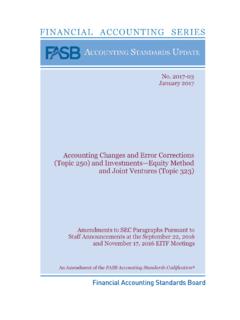Transcription of Division of Local Government and School Accountability ...
1 Division of Local Government and School AccountabilityOffice of the New York State ComptrollerAccounting and Reporting ManualThomas P. DiNapoli State ComptrollerMRAC ounties, Cities, Towns and VillagesSoil and Water Conservation DistrictsLibrariesFor additional copies of this report contact:Comptroller s Press Office 110 State Street, 15th floor Albany, New York 12236 (518) 474-4015 or email us: be removed from our mailing list: In an effort to reduce the cost of printing, if you would like to have your name removed from our mailing list or if your present address has changed, contact the Comptroller s Press Office at (518) 474-4015 or Office of the State Comptroller, 110 State Street, 15th Floor, Albany, NY 12236. Date of Issue: January 2009 Revised January 2011 Reprinted January 2016 Table of ContentsPart 1 accounting and ReportingChapter 1 Introduction ..3 Chapter 2 Basic Governmental accounting Principles.
2 6 Chapter 3 Measurement Focus and Basis of accounting ..12 Chapter 4 Funds and Supplemental Schedules ..15 Chapter 5 Classification and Coding ..18 Chapter 6 Budgeting ..22 Chapter 7 Defining the Financial Reporting Entity ..27 Chapter 8 Financial Reporting ..36 Chapter 9 GASB Statement No. 34 ..38 Chapter 10 Sample Journal Entries ..42 Budget Entries ..43 Real Property Tax Entries ..46 Revenue Entries ..62 Expenditures and Encumbrance Entries ..68 Accrued Liabilities Entries ..71 Prepaid Expense Entries ..71 Judgments and Claims Entries ..72 Capital Projects Fund Entries ..74 Indebtedness Entries ..78 Petty Cash and Departmental Cash Fund Entries ..84 Reserve Entries ..85 Chapter 11 Soil and Water Conservation Districts ..88 Chapter 12 Libraries ..92 General Ledger Codes ..92 Revenue Codes ..94 Expenditure Codes ..95 Table of ContentsTable of ContentsPart II ReferencesGeneral Ledger Account Codes ..97 Definitions ..107 Revenue Account Codes ..117 Definitions.
3 137 Expenditure Account Codes ..161 Definitions ..173 Terminology ..190 Useful Links: ..215 OSC Central Office Listing ..216 Regional Office Listing ..217 Chapter 1 Introduction - 3 Chapter 1 IntroductionThe Office of the State Comptroller (OSC) has compiled this manual as a comprehensive accounting guide for Local officials and others interested in accounting by Local governments in New York State. It provides an overview of generally accepted governmental accounting and financial reporting principles, and OSC s interpretations of such principles, where pronouncements are silent or do not address problems common among jurisdictions within New York basic responsibility for oversight of Local governments by the State Comptroller is contained in the State Constitution and Article 3 of the General Municipal Law (GML). Among other things, the State Comptroller has authority to: perform audits (GML, Sections 33, 34, 35), prescribe information to be included in annual financial reports (GML, Sections 30, 31, 32), prescribe a uniform system of accounts (GML, Section 36), and prepare an annual report to the State Legislature (GML, Section 37).
4 Since the late 1970 s, there have been increasing demands on a national level for standardization of accounting and financial reporting practices. The fiscal crisis in certain cities, increasing governmental spending and needs of the investment community and grantors were a driving force behind these 1977, OSC made a commitment to prescribe accounting systems which conform to Generally Accepted accounting Principles (GAAP). OSC prescribes a Uniform Systems of Accounts pursuant to General Municipal Law, Section 36. The System of Accounts provides for a standard chart of accounts and fund structure that is the basis for the uniform annual financial reports required to be filed with the State Comptroller pursuant to General Municipal Law, Section Accepted accounting Principles for Governmental UnitsGenerally Accepted accounting Principles (GAAP) are uniform minimum standards of and guidelines to financial accounting and reporting. They are the framework within which financial transactions are recorded and reported resulting in financial statements that provide comparability between governmental entities, consistency between accounting periods and reliability for internal and external users of financial GAAP for Local governments is not static but evolving, the Office of the State Comptroller is involved in such activities as monitoring and responding to proposed pronouncements; amending the accounting Systems when appropriate in light of new or revised standards ; and assisting Local officials in understanding and implementing GAAP through conferences, workshops and seminars.
5 This manual is an example of this brief overview of the history of standard setting for private enterprises and for Government is helpful in understanding the sources of GAAP for governments. The first formal efforts to establish GAAP for private enterprises began in 1930 in response to the financial difficulties experienced during the Great Depression. Over the years, the American Institute of Certified Public Accountants (AICPA) established GAAP. In 1973, the Financial accounting standards Board (FASB) was 4 - accounting and Reporting Manualformed. Since 1973, FASB has prescribed GAAP for commercial and non-profit organizations. FASB operates under the auspices of the Financial accounting Foundation (FAF), an independent non-profit foundation. GAAP for state and Local governments were originally sponsored by the Municipal Finance Officers Association (MFOA), now known as the Government Finance Officers Association (GFOA), through a group known as the National Committee on Municipal accounting (NCMA).
6 After some years, this committee was replaced by another MFOA-sponsored group, the National Committee on Governmental accounting , which itself was eventually expanded and renamed the National Council on Governmental accounting (NCGA). The MFOA s guidance was incorporated into various editions of a publication that came to be known commonly as the blue book. The first edition was published in 1934. The third edition published in 1968 inaugurated the format still used today in the current edition. In 1974, the AICPA issued their accounting and auditing guide, Audits of State and Local Governmental Units (ASLGU), which stated that the AICPA deemed the 1968 Blue Book to be GAAP for governmental units. In the late 1970 s, partly in response to the fiscal crisis in New York City and several other cities, the NCGA began to issue statements and interpretations. Eventually, the NCGA decided that these pronouncements, rather than the blue book, should be authoritative. Consequently, later editions of the blue book are not GAAP, but merely illustrate what is common practice.
7 As mentioned earlier, private-sector standard setting was eventually transferred from the AICPA to the FAF. Developments in the public sector took a very similar course. In 1984, the responsibility of setting GAAP for state and Local governments was transferred from the NCGA to the Governmental accounting standards Board (GASB). Like the FASB, the GASB functions under the auspices of the FAF. In short, the following have been the standard setting bodies for GAAP for state and Local governments: National Committee on Municipal accounting 1934-1948 National Committee on Governmental accounting 1948-1974 National Council on Governmental accounting 1974-1984 Governmental accounting standards Board 1984-PresentThe GASB is the highest, but not the sole, source of GAAP for state and Local governments. When accounting issues are not covered by GASB guidance, guidance from the American Institute of CPAs (AICPA), Government Finance Officers Association (GFOA), the Financial accounting standards Board (FASB) and other sources is used following a prescribed 1 Introduction - 5 GAAP HierarchyLevel * GASBAICPAO therLevel 1 Statements and InterpretationsLevel 2 Technical BulletinsAudit and accounting Guides/Statements of Positions (SOPs) (Specific to Government and cleared by GASB)Level 3 Emerging Issues Task Force Consensus PositionsAccounting standards Executive Committee (AcSEC) Practice Bulletin (Specific to Government and cleared by GASB)Level 4 Implementation GuidesAudit Guides/SOPs (Specific to Governments, but Not cleared by GASB)Widely recognized and prevalent practiceOther SourcesConcept StatementsAccounting Literature* The GAAP hierarchy is established by Statement on Auditing standards (SAS) No.
8 69, The Meaning of Present Fairly in Conformity with Generally Accepted accounting Principles in the Independent Auditor s Report, issued by the American Institute of Certified Public Accountants in 2 provides an explanation of the Basic Governmental accounting following is the hierarchy of GAAP:6 - accounting and Reporting ManualChapter 2 Basic Governmental accounting PrinciplesGOVERNMENTAL accounting PRINCIPLES: The following are basic principles of accounting and reporting applicable to fund based accounting for Local governments: accounting and Reporting CapabilitiesFund accounting SystemsFund TypesNumber of FundsReporting Capital AssetsValuation of Capital AssetsDepreciation and Impairment of Capital AssetsReporting Long-Term LiabilitiesMeasurement Focus and Basis of AccountingBudgeting, Budgetary Control and Budgetary ReportingTransfers, Revenues, Expenditures, and Expense Account ClassificationCommon Terminology and ClassificationInterim and Annual Financial ReportsPrinciple accounting and Reporting CapabilitiesPurpose: Explains the requirements for accounting records and :A governmental accounting system must make it possible both:(a) to present fairly and with full disclosure the funds and activities of the governmental unit in conformity with generally accepted accounting principles; and(b) to determine and demonstrate compliance with financial-related legal and contractual provisions.
9 Reference: GASB Codification Section 1200In New York State there are few, if any, provisions of general statutory law that conflict with GAAP. However, if conflict does exist, financial statements must be prepared in conformance with GAAP. This does not mean that two accounting systems should be maintained. Books of account should be maintained on a legal-compliance basis, but should include sufficient additional reports to permit GAAP-based reporting. Chapter 2 Basic Governmental accounting Principles - 7 Principle Fund accounting SystemsPurpose: Explains funds and their :Governmental accounting systems should be organized and operated on a fund basis. A fund is defined as a fiscal and accounting entity with a self-balancing set of accounts recording cash and other financial resources, together with all related liabilities and residual equity or balances, and changes therein, which are segregated for the purpose of carrying on specific activities or attaining certain objectives in accordance with special regulations, restrictions or : GASB Codification Section 1300 Principle Fund Types Purpose: Explains the types of funds and the account :There are three categories of funds used in governmental accounting : Governmental Funds, Proprietary Funds and Fiduciary : GASB Codification Section 1300 Governmental Funds account for most governmental General Fund accounts for all financial resources except those required to be accounted for in another Revenue Funds account for the proceeds of specific revenue sources that are legally restricted to expenditures for a specific purpose.
10 Capital Projects Funds account for financial resources to be used for the acquisition or construction of major capital facilities. Debt Service Funds account for the accumulation of resources for, and the payment of, general long term debt principal and interest. Permanent Funds account for resources that are legally restricted to the extent that only earnings, not principal, may be used for purposes that benefit the Government or its citizenry. These non-expendable trusts were previously accounted for in the trust and agency fund. Expendable trusts that benefit the Government are accounted for as miscellaneous Special Revenue Funds (CM).Proprietary Funds account for a Government s ongoing activities that are similar to those found in the private sector. 8 - accounting and Reporting ManualEnterprise Funds account for operations (a) that are financed and operated in a manner similar to private business where the intent of the governing body is that the cost (expenses, including depreciation) of providing goods or services to the general public on a continuing basis be financed and recovered primarily through user charges; or (b) where the governing body has decided that periodic determination of revenues earned, expenses incurred, and/or net income is appropriate for capital maintenance, public policy, management control, Accountability , or other purposes.

